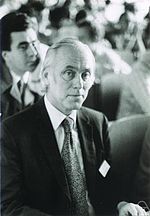Theodore Wilbur Anderson | |
|---|---|
 T. W. Anderson in 1974 | |
| Born | June 5, 1918 Minneapolis, Minnesota, U.S. |
| Died | September 17, 2016 (aged 98) Stanford, California, U.S. |
| Nationality | American |
| Alma mater | Princeton University, Northwestern University |
| Known for | Anderson–Darling test, Anderson–Bahadur algorithm |
| Scientific career | |
| Fields | Mathematical statistics |
| Institutions | Columbia University, Stanford University |
| Doctoral advisor | Samuel S. Wilks |
| Doctoral students | John B. Taylor Cheng Hsiao[1] |
Theodore Wilbur Anderson (June 5, 1918 – September 17, 2016) was an American mathematician and statistician who specialized in the analysis of multivariate data. He was born in Minneapolis, Minnesota.[2] He was on the faculty of Columbia University from 1946 until moving to Stanford University in 1967, becoming Emeritus Professor in 1988. He served as Editor of Annals of Mathematical Statistics from 1950 to 1952. He was elected President of the Institute of Mathematical Statistics in 1962.
Anderson's 1958[3] textbook, An Introduction to Multivariate Analysis,[4] educated a generation of theorists and applied statisticians; Anderson's book emphasizes hypothesis testing via likelihood ratio tests and the properties of power functions: Admissibility, unbiasedness and monotonicity.[5][6]
Anderson is also known for Anderson–Darling test of whether there is evidence that a given sample of data did not arise from a given probability distribution.
He also framed the Anderson–Bahadur algorithm[7] along with Raghu Raj Bahadur, which is used in statistics and engineering for solving binary classification problems when the underlying data have multivariate normal distributions with different covariance matrices.
- ^ Taylor, John B. (September 24, 2016). "The Statistical Analysis of Policy Rules". economicsone.com. Economics One (A blog by John B. Taylor). Retrieved October 3, 2016.
- ^ "IWMS´08 - 17th International Workshop on Matrices and Statistics". www.ccc.ipt.pt. Retrieved 2016-06-12.
- ^ Täonu Kollo; Dietrich von Rosen (1 January 2005). Advanced Multivariate Statistics with Matrices. Springer. pp. 13–. ISBN 978-1-4020-3419-0. Retrieved 17 June 2013.
- ^ Anderson, T.W. (2004). An introduction to multivariate statistical analysis (3rd ed.). New York: John Wiley and Sons. ISBN 9789812530967.
- ^ Sen, Pranab Kumar; Anderson, T. W.; Arnold, S. F.; Eaton, M. L.; Giri, N. C.; Gnanadesikan, R.; Kendall, M. G.; Kshirsagar, A. M.; et al. (June 1986). "Review: Contemporary Textbooks on Multivariate Statistical Analysis: A Panoramic Appraisal and Critique". Journal of the American Statistical Association. 81 (394): 560–564. doi:10.2307/2289251. ISSN 0162-1459. JSTOR 2289251.(Pages 560–561)
- ^ Schervish, Mark J. (November 1987). "A Review of Multivariate Analysis". Statistical Science. 2 (4): 396–413. doi:10.1214/ss/1177013111. ISSN 0883-4237. JSTOR 2245530.
- ^ Classification into two multivariate normal distributions with different covariance matrices (1962), T W Anderson, R R Bahadur, Annals of Mathematical Statistics